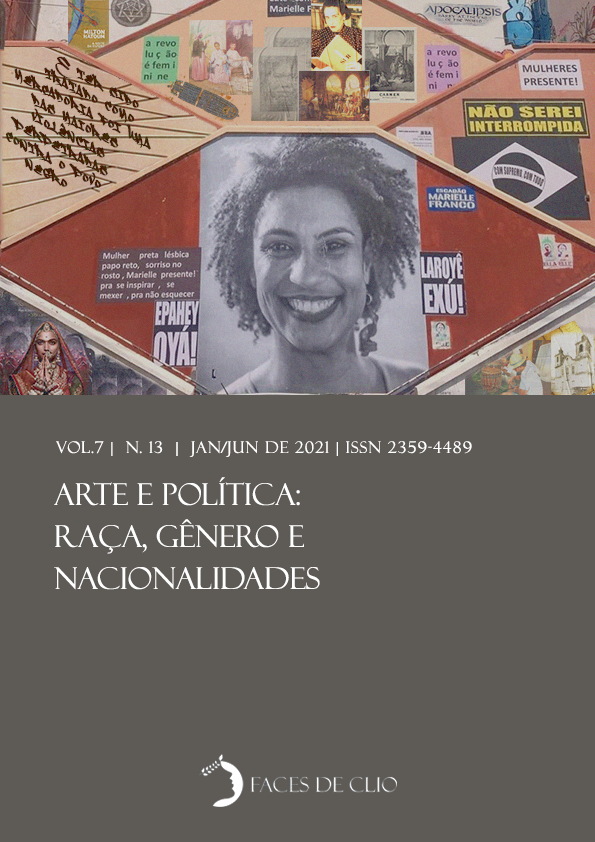Diálogos intermidiáticos em games
Recepções do Medievo em um estudo de caso no jogo Apocalipsis: Harry at the end of the world
DOI:
https://doi.org/10.34019/2359-4489.2021.v7.32311Palabras clave:
videogames, intermidialidade, retrolugaresResumen
O objetivo desta investigação é analisar comparativamente algumas capturas de tela do videogame Apocalipsis: Harry at the end of the world com imagens oriundas dos séculos XV – XVI (ou seja, a construção dos desenvolvedores com as fontes originais), tais como xilogravuras de Michael Wolgemut, Albrecht Durer e pinturas de Hieronymus Bosch e Pieter Bruegel, o Velho que podem ter servido de inspiração para a estética do jogo, procurando perceber onde os desenvolvedores fizeram adaptações na busca da criação de algo novo, o que eles recepcionaram, relacionando história e videogame via imagem. Para isso, nosso embasamento teórico partirá de leituras de Umberto Eco sobre a presença da Idade Média hoje, no conceito de intermidialidade exposto por Claus Clüver e no conceito de retrolugares proposto por Alberto Venegas Ramos.
Descargas
Citas
APOCALIPSIS Full Walkthrough and Guide - Harry at the end of the world. Disponível em: https://steamcommunity.com/sharedfiles/filedetails/?id=1318461892&fbclid=IwAR3cNNPBu_IMAMuQy_sC6CTTQZdesoS87o2Jiby63o-OuyHFffbNE91Cs3Q. Acesso em: 23 set. 2020.
BOSCH, Hieronymus. The Ship of Fools, or the Satire of the Debauched Revelers. 1490 - 1500. Disponível em: https://www.louvre.fr/en/oeuvre-notices/ship-fools-or-satire-debauched-revelers. Acesso em: 23 set. 2020.
BRANT, Sebastian. A nau dos insensatos. São Paulo: Octavo, 2010. p. 13 - 20. Disponível em: https://www.yumpu.com/pt/document/read/11925121/a-nau-dos-insensatos-octavo. Acesso em: 23 set. 2020.
BRUEGEL, Pieter. Die großen Fische fressen die kleinen. 1557. Disponível em: https://artsandculture.google.com/asset/die-gro%C3%9Fen-fische-fressen-die-kleinen/aQFkPLpr4RSdLQ?hl=de&fbclid=IwAR1pr81IqMH0BQHIEwRtBCQl44dwINa8K7_UvcRAivZJ1MdKcjWfii5gtuU. Acesso em: 23 set. 2020.
PUNCH Punk Games. Apocalipsis. Varsóvia, 28 fev. 2018. Disponível em: https://store.steampowered.com/app/505330/Apocalipsis/. Acesso em: 23 set. 2020.
SCHEDEL, Hartmann. Liber chronicarum. Nuremberg, 1493. Disponível em: https://digi.ub.uni-heidelberg.de/diglit/is00309000. Acesso em: 23 set. 2020.
Referências bibliográficas
CLÜVER, Claus. Intermidialidade. Pós, 1 (2), p. 8-23, 2011. Disponível em: https://periodicos.ufmg.br/index.php/revistapos/article/view/15413. Acesso em: 23 set. 2020.
ECO, Umberto. Dez modos de sonhar a Idade Média. In: ECO, Umberto. Sobre os espelhos e outros ensaios. Tradução de Beatriz Borges. Rio de Janeiro: Nova Fronteira, 1989, p. 74-85.
ECO, Umberto. Viagem na irrealidade cotidiana. Tradução de Aurora Fornoni Bernardini e Homero Freitas de Andrade. Rio de Janeiro: Nova Fronteira, 1984, p. 9-18.
FRITH, John. The History of Plague – Part 1. The Three Great Pandemics. Journal of Military and Veterans’ Health, v. 20, n. 2, p. 11 - 16, 2012. Disponível em: https://jmvh.org/wp-content/uploads/2012/12/JMVH_History-of-Plague.pdf. Acesso em: 23 set. 2020.
GABRIELE, Matthew. How A Medieval Video Game Can Help Us Think About The Past. Forbes, 27 jan. 2019. Disponível em: https://www.forbes.com/sites/matthewgabriele/2019/01/27/medieval-video-game-think-about-past/?fbclid=IwAR3tmEojxtxNItqu02ZkRnvpfqmvUbw2P5AOAWALVCyIeYeHcWA6_mJhQic#412e64533cb8. Acesso em: 23 set. 2020.
GÓMEZ, Guillermo Stefano Rosa; PERNAS, Rafael de Moura. O pistoleiro narrador: convergências entre narrativa e mecânica no jogo eletrônico Call of Juarez: Gunslinger. In: COLLARES, Marco Antonio; FILHO, Artur Rodrigo; LOPES, Aristeu Machado. A história através das mídias: representações, personagens, fontes. Curitiba: Brazil Publishing, 2019, p. 146 – 161.
MEUWESE, Martine. The animation of Marginal Decorations in “Monty Python and the Holy Grail”. Arthuriana, vol. 14, n. 4, 2004, p. 45 - 58. Disponível em: https://www.jstor.org/stable/27870655?seq=1#page_scan_tab_contents. Acesso em: 23 set. 2020.
PERNAS, Rafael de Moura. “Ser” ser humano: projetando o futuro em relação ao humano-máquina nas narrativas dos jogos de Call of Duty: Black Ops III, Soma e The Talos Principle. 2019, 179 f. Dissertação (Mestrado em História) - Programa de Pós-Graduação em História, Instituto de Ciências Humanas, Universidade Federal de Pelotas, Pelotas, 2019.
PORTO, César Henrique de Queiroz; SILVA, Luiz Gustavo Soares. Cultura da mídia e medievalidade: uma análise do videojogo Assassin’s Creed. Domínios da Imagem, Londrina, v. 9, n. 17, p. 257-276, jan./jun. 2015. Disponível em: http://www.uel.br/revistas/uel/index.php/dominiosdaimagem/article/view/22693. Acesso em: 23 set. 2020.
QUEM inventou o videogame? Superinteressante. 1 jun 2016. Disponível em: https://super.abril.com.br/blog/oraculo/quem-inventou-o-videogame/. Acesso em: 23 set. 2020.
RAMOS, Alberto Venegas. Retrolugares, definición, formación y repetición de lugares, escenarios y escenas imaginados del pasado en la cultura popular y el videojuego. Revista de historiografia 28, p. 323 – 346, 2018. Disponível em: https://www.historiayvideojuegos.com/articulo-retrolugares-definicion-formacion-y-repeticion-de-lugares-escenarios-y-escenas-imaginados-del-pasado-en-la-cultura-popular-y-el-videojuego/. Acesso em: 14 jun. 2020.
ROLLAND, Cintia Alfieri Gama. Evitando a “Segunda Morte”: a necessidade alimentar do morto para manter-se vivo no Egito Antigo. Rever (PUCSP), v. 15, p. 10 - 30, 2015. Disponível em: https://revistas.pucsp.br/rever/article/view/23582. Acesso em: 23 set. 2020.
SCHELL, Jesse. A arte de game design: o livro original. Rio de Janeiro: Elsevier, 2011. p. 39 – 46.
SCHMITT, Juliana. O estudo das Danças Macabras medievais: entre o visível, o oculto e o destruído. Revista ARA, v. 3, p. 231-253, 2017. Disponível em: http://www.revistas.usp.br/revistaara/article/view/139433. Acesso em: 14 jun. 2020.
SILVA, Daniele Gallindo G. Sobre "cavaleiras": a (re)criação do medievo em Cornelia Funke. Pandaemonium Germanicum, v. 19, n. 29, p. 1-20, 2016. Disponível em: http://www.revistas.usp.br/pg/article/view/128165. Acesso em: 23 set. 2020.
SOUZA, Vinícius. Análise da imagem visual em videogames. 2016, 323 f. Dissertação (Mestrado em Design) - Programa de Pós-Graduação em Design, Escola de Engenharia, Universidade Federal do Rio Grande do Sul, Porto Alegre, 2016.
VOLOBUEF, Karin. Introdução. In: BRANT, Sebastian. A nau dos insensatos. São Paulo: Octavo, 2010. p. 13 - 18.
Descargas
Publicado
Cómo citar
Número
Sección
Licencia
Derechos de autor 2021 Bárbara Denise Xavier da Costa

Esta obra está bajo una licencia internacional Creative Commons Atribución 4.0.


